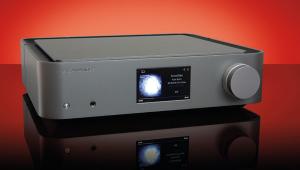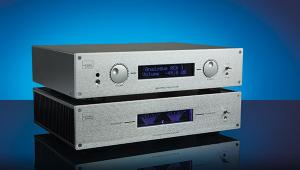Mark Levinson No. 326S - £8,000

What better time than the new era of austerity for us to discover how much difference a really good preamplifier can make to an already impressive high-end system.
Mark Levinson was one of the first to build seriously engineered high-end amplifiers. We don’t mean excessively large or massively powerful, although it was ahead of the power game, we mean Rolls Royce or SME-style build quality.
It’s unusual for us to review a preamplifier on its own, but the new No.326S is such a phenomenal- sounding piece of equipment that we had to tell you about it. In truth, this product has rearranged our notion of what really counts in a high-end system and that doesn’t happen very often.
Steel shieldAt present, the No.326S is the only preamplifier in the Mark Levinson range, which seems a little incongruous in the context of its power amps which top out at £40K (for a pair of No.53 monoblocks), a matching reference preamp is on the way to plug that gap, but this compact beast is probably up to the job.
It has been painstakingly designed to keep all forms of noise away from the power supply and hence the audio signal itself. This is achieved with shielding in the form of steel boxes encasing both signal processing circuitry and the power supply itself.
It is dual-mono right back to the mains transformer – there are two of these, but not for each channel – one is for the control circuitry. Internally it’s separated into three sections: power supply, signal processing and control circuitry. Incoming AC is heavily filtered using noise suppression and isolation techniques of the variety usually found in external power filters, all of which is designed to keep the signal as clean as possible.
The PCB itself is made of Nelco, which replaces Arlon in the previous incarnation and is said to have even better dielectric (insulating) properties.
In practical terms, it’s an extremely flexible workhorse, with seven inputs in both balanced and single- ended varieties and for each of these you can set the gain and dial-in a name of your choice, so long as it doesn’t exceed seven characters. What’s more, doing so is remarkably intuitive and we managed it without a manual (all too often extra facilities means extra complication, but with the dot-matrix display this preamp is as easy to use as it is to enjoy, well almost).
Another very nice touch is the way that the volume is faded down and then up when changing inputs, which gives you a few microseconds to switch back if the next source is too loud. Of course, if you’ve set input gain properly this shouldn’t happen too often, but there are always rogue recordings with silly levels.
Volume is indicated in tenths of a decibel (above 23dB, 1dB increments below that) which seems a little bit on the fine side – it makes changing level with the remote a bit slow – but these steps come into their own at the top and bottom of the range where small increments are more useful.
If you want to reduce volume quickly the mute button is the best bet, especially as you can dial in just how much attenuation you want. There are two volume attenuators inside the box, one for each channel, continuing the dual-mono theme.
Useful features include a mono setting for older recordings – the Beatles mono box set sounds significantly better than its stereo counterpart for instance – and polarity or phase inversion, both available on the remote handset.
Extra milesThe supplied remote is a comfy lump with a rubber pad on the underside so that it doesn’t slip off the sofa, plus it has a reassuringly heavy build that exudes nearly as much quality as the unit itself. But not quite, there is something about the quality of metalwork, fit and finish of Mark Levinson products that puts them at the top of the tree. Maybe it’s because they were among the first to go the extra mile in this department, but whatever it is, it’s certainly reassuring when you are being asked to shell out the readies.
Everything from the matte-finished buttons and knobs to the anodised metalwork of the chassis exudes quality and durability. The RCA phono sockets are made to M-L’s design and are a shade smaller than usual, which is very nice when you have extremely tight-fitting plugs to deal with, as is often the case with high-end cables.
In terms of value, the No.326S looks pretty strong, it’s very expensive granted, but it is built with utmost attention to detail by a company with a track record for making some of the best amplifiers in the business. Bowers & Wilkins does all its listening and tuning using a pair of Mark Levinson No.33 monoblocks and has been doing so for years.
Wonder drugOur first impression with this preamp was not necessarily positive, because it seems to remove all the edges from the sound, smoothing things out and giving the impression of reduced detail. But it’s not very long before it becomes apparent, that what has been removed is hash in the high frequencies, essentially noise that most amplifiers add to the signal in such a subtle way that it seems like part of the music, but once it’s taken away the amount of musical and spatial detail that comes through is nothing short of astonishing. It’s not just audiophilia either, by which we mean it’s more than sound effects like sparkly highs or bone-crunching lows against an ‘inky black’ background. It’s more of the notes, more of the acoustic, more of the production and more of the music.It’s surprising that any one component can do all this, let alone the one that changes the volume, yet this is clearly a very difficult thing to do really well otherwise the No.326S wouldn’t stand out so dramatically.
Led Zeppelin III is one of our favourite albums, it captures the band as it reached its creative peak and is remarkably well recorded to boot. The preamp delivered Bonzo’s chugging beats and Percy’s voice at its finest, while focussing on the remarkably inventive compositions of Page and Jones. All the micro- dynamics are there to be enjoyed alongside the compressed vocals that seem so small compared to the band.
This was a revelatory experience and one that continued with every familiar album. It literally makes you cast your troubles aside and live for the music, which can’t be bad at any price.
Sonic goldWhat also makes this component worth its weight in sonic gold is the incredible three dimensionality it can produce, its uncannily clean sound which allows you to play at silly levels without discomfort and a world-beating sense of timing.
Bass lines are reproduced with a coherence and precision that is all too rare and this foundation means that rhythm and melody are delivered in a totally coherent, fluid fashion.
This and the ability to show you the fine details of the recording in the context of a gripping overall presentation makes the No. 326S an addictive bit of kit. Okay, so the price is high, but the rewards are truly the stuff of a music lover’s dream.
LIKE: Excellent USB implementation, natural sound, solid build
DISLIKE: We can’t afford one and life seems a bit dull now it’s gone!
WE SAY: We can’t overstate how much insight and audio performance is offered by this amp
DETAILS
PRODUCT: Mark Levinson No.326S
ORIGIN: UK
TYPE: Preamplifier
WEIGHT: 14kg
DIMENSIONS: (WxHxD) 705x450x345mm
FEATURES:
• Inputs: 3x XLR, 4x RCA phono
• Outputs: XLR, RCA phono, tape
• 3.5mm trigger output
• optional phono stage
• RJ-45 connectors for Link comms
DISTRIBUTOR: CSE Custom
TELEPHONE: 01423 359054
WEBSITE: marklevinson.com
 |
Inside this month's issue:
WiiM Ultra, System Audio Signature 5, Monitor Audio Studio 89, Volumio Rivo, SVS Ultra Evolution Nano, iFi Audio ZEN Blue 3 and much, much more
|





















































